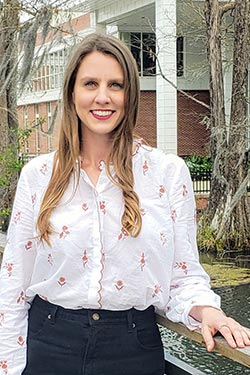Coastal Science Assistantship Projects Announced for 2022
The Louisiana Coastal Protection and Restoration Authority (CPRA) continues its commitment to the Coastal Science Assistantship Program (CSAP). This program supports Master of Science students in science or engineering research relevant to Louisiana coastal protection efforts. This collaboration offers the dual benefit of engaging students in CPRA activities while potentially recruiting qualified personnel for the agency.
The Louisiana Sea Grant College Program (LSG) administers these assistantships available to all Louisiana university faculty to recruit outstanding students to coastal restoration-related research. Annually, four new students are chosen, based on the review of proposals, and awarded $25,000 each for up to three years. The latest recipients are:
 Bonnie J. Slaton, University of Louisiana at Lafayette (ULL)
Bonnie J. Slaton, University of Louisiana at Lafayette (ULL)
Major Professor: Paul Leberg
Title: Assessing Resiliency of Coastal Seabird Communities Following Coastal Restoration and Hurricane Disturbance
Coastal islands in the Terrebonne and Barataria basins are critical habitats for several threatened species facing range-wide impacts due to climate change. Slaton will study the effects of storms and restoration on successional processes that control avian populations. She will compare extensive pre-storm and current island conditions, assessing restored and unrestored islands and the wildlife that inhabit them, such as brown pelicans (Pelicanus occidentalis). Ultimately, this project will help inform future restoration practices. After obtaining her master’s, Slaton plans to work as a non-game avian biologist on the Louisiana coast, protecting bird species and their habitats.
Student to be determined, Louisiana State University (LSU)
Major professor: Sabarethinam Kameshwar
Title: Hurricane Vulnerability of Aboveground Storage Tanks in Coastal Louisiana
Coastal Louisiana houses several ports, petrochemical industry installations and oil and gas facilities. Aboveground storage tanks (ASTs) are widely used in these industries to store a variety of substances, such as crude oil, petrochemicals and other hazardous substances. ASTs are susceptible to failure during hurricanes, disrupting the oil and gas supply chain and causing hazardous spills that damage surrounding eco-systems and communities. One noted incident – the Murphy Oil spill – occurred after Hurricane Katrina in Meraux. More than 25,000 barrels of mixed crude oil were released into the surrounding environment. This research project focuses on filling the knowledge gaps related to understanding and quantifying the vulnerability of ASTs during hurricanes and estimating the effectiveness of regional hurricane risk mitigation measures in preventing AST failures.
Student to be determined, Louisiana Tech
Major Professor: Jay Wang
Title: Development of Design Criteria for the use of Articulating Concrete Mats and Geosynthetic Separator Fabric as Protective Features for Earthen Containment Dikes Exposed to Localized Wave Forces
Coastal wetland loss in Louisiana is a complex issue. Solutions include constructing containment dikes to restore and protect coastal habitats. Earthen dikes along the shoreline are typically built on soft clay, silts or fine sands and are different from levees because the dikes are subjected to continued damaging high current, wave and pore water pressure conditions. This project involves developing construction criteria for earthen dikes – using geosynthetic separator fabric and concrete mats as protective features – for coastal marsh creation. Ultimately, the project aims to deliver detailed step-by-step procedures for earthen dike construction.
Student to be determined, University of New Orleans (UNO)
Major professor: Madeline Foster-Martinez
Title: How do Physical Properties of Vegetation Modify the In-situ Flow and Sediment Regime?
Reestablishing marsh vegetation is integral to Louisiana’s coastal restoration efforts. Many perceive vegetation’s role in land building as adding friction and slowing currents to cause sediment deposits. However, that is not always the case. Dense vegetation can divert water around areas of emerging marsh and prevent sediment-laden water from contributing to land building. This project will study how physical properties (i.e., shape, height, stem width, branching, flexibility, etc.) of vegetation modify water flow and the sediment regime in Bay Denesse. With vegetation plantings costing thousands of dollars per acre, understanding the impact of vegetation’s physical properties on sedimentation can result in more efficient use of coastal restoration funding.
